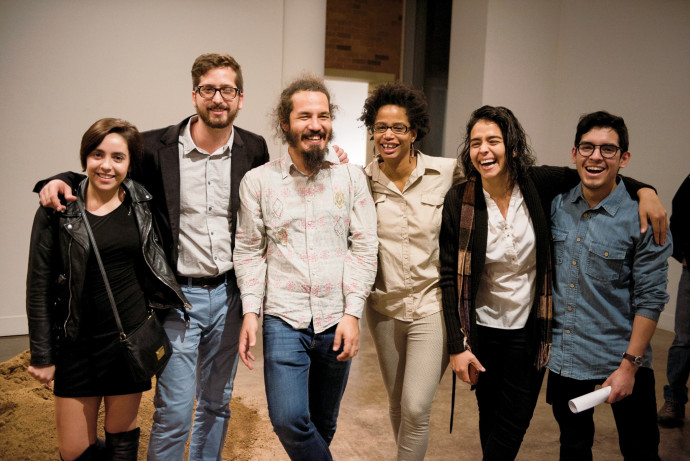Foreign Exchange
How Lewis & Clark’s Cuban connections—and global-minded students—brought a world-class exhibition to the Hoffman Gallery.
by Jonathan Frochtzwajg BA ’09
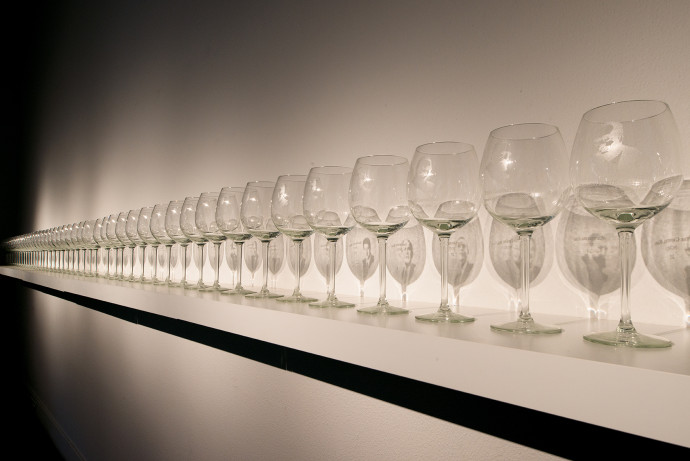
A long line of wine glasses, each etched with the face of an American or Cuban political leader, sits atop a white shelf in Lewis & Clark’s Hoffman Gallery of Contemporary Art.
To scan the faces of these presidents and presidentes as they converge toward the present—with Barack Obama and Raúl Castro meeting in the center—is to take in, at a glance, the complicated historical relationship between the United States and its Communist neighbor. It’s a striking image, particularly at a moment when the two nations seem ever closer to clinking glasses.
This centuries-long toast in progress, titled The Crystal Kiss, is a piece by Havana-based artist Reynier Leyva Novo; it was on display as part of the Hoffman Gallery’s recent exhibition of work by six emerging Cuban artists, Intersecciones: Havana-Portland. Like the U.S.-Cuba rapprochement, Intersecciones was the result of a unique history and many different players, including a history professor with Havana savvy, intrepid students past and present, and a Cuba-curious gallery director.
Art School Coincidental
It all began in 2004, when Lewis & Clark established its overseas study program in Cuba. The program was spearheaded by Elliott Young, professor of history and a Latin America specialist. At the time, the University of Havana, where most U.S. study-abroad programs in Cuba are based, was overpopulated, so a third-party organization with which Young was working suggested he ask Havana’s elite Instituto Superior de Arte (ISA) if it would host his students—a rather confusing request, given that the L&C program was unrelated to art. “They couldn’t quite figure out why we wanted to be there,” Young recalls. To make matters worse, it was a frosty time in Washington-Havana relations, and Americans were viewed with suspicion; years later, the head of the art school told Young he had initially figured him for a CIA agent.
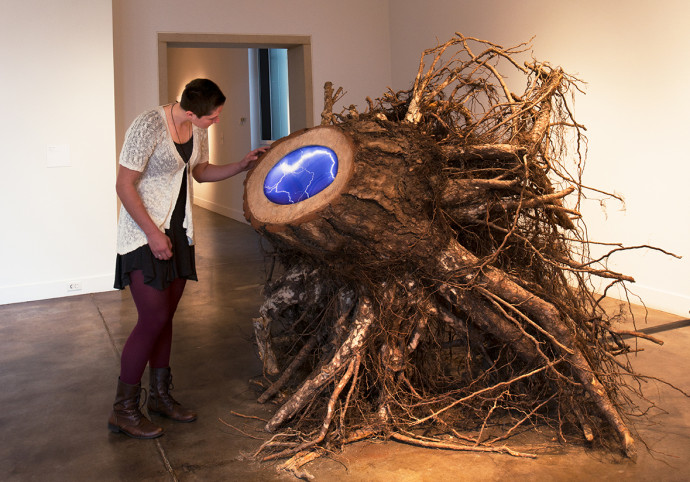
Suspicions notwithstanding, ISA agreed to house Lewis & Clark’s program—and that, Young says, has made all the difference. While the University of Havana is overseen by the buttoned-down Ministry of Education, ISA falls under the comparatively casual Ministry of Culture. That has meant that L&C students studying in Cuba have opportunities other foreign students don’t, including home stays and independently organized classes. “As a result of that relationship, we have a much more open and critical program,” says Young.
The same year the program started, President George W. Bush tightened restrictions on educational programs in Cuba—requiring, for example, that these programs have a direct relationship with a higher education institution in the country. Lewis & Clark’s ties to ISA allowed it to remain in Cuba while many other schools were forced to leave, making its program one of the longest running on the island today.
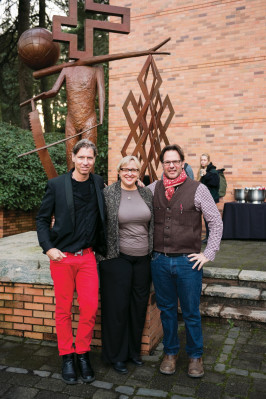
Today, Lewis & Clark sends students to Havana every other spring, where they study Cuban history and hone their Spanish skills. It’s a perennially popular overseas study offering—in part because this tropical, socialist isle is something of a “forbidden fruit” for Americans, and in part because the country provides a historical and sociological case study like no other. Settled by Spain as one of the first colonies in the Americas, Cuba was occupied by the United States in the late 1800s, became an independent nation (though one still firmly within America’s sphere) in the early 20th century, and later, of course, underwent its famous Communist revolution.
“There is no other country that has had that breadth of history within such a short amount of time,” Young observes. “If you want to study slavery, if you want to study revolution, if you want to study intercultural relations, you can do it all on this island.” But something more than history beckons Havana habitués like Young, who has personally led Lewis & Clark’s Cuba program three times. “For me, it’s this frustrating place that will tear your heart out, but there’s something invigorating about the amazing resilience of the people,” he says. “Despite conditions being very hard, there’s a kind of joy to living there that you don’t find in Portland, where we have everything.”
That’s reflected in a rich, internationally recognized art scene—one with which Young became familiar over the years through Lewis & Clark’s association with ISA. But despite being based at Cuba’s premier art school, the college’s program largely ran parallel to the country’s art community—until a strike in Chile caused their paths to cross.
Students in the Vanguard
It was 2011, and Sam Ashman BA ’12 was studying abroad in Chile when the country’s public university students went on strike, effectively cancelling classes. Newly equipped with Spanish proficiency and needing a challenge, Ashman—whose father is the director of the Museum of Latin American Art in Long Beach, California—called a friend, Drew Lenihan BA ’12, and proposed doing some kind of creative project around the Havana Biennial art festival the following year. This was squarely in Lenihan’s wheelhouse: at the time, the sociology and anthropology major was conducting interviews in Spain for a thesis about public art.
Back on campus, the pair organized an art-focused student trip to Cuba through L&C’s Alternative Spring Break program, recruiting nine other students to join them. (Young served as the trip’s faculty advisor.) In March 2012, the group traveled to the Cuban capital, where each participant paired off with an art student at ISA to collaboratively create a piece of art. Meanwhile, Ashman, Lenihan, and another trip participant, Spencer Byrne-Seres BA ’13, started working on a documentary about the biennial, interviewing dozens of Cuban artists about their work, their views on art, and life in Cuba. (The film that ultimately resulted, Luz y Sombra [Light and Shadow], was selected for Havana’s International Festival of New Latin American Cinema in 2014.) “I’m really thankful for the fact that I was able to do something like that, even though I was studying philosophy,” says Ashman.
The summer after the Alternative Spring Break trip, the artwork that participants had created with their Cuban counterparts was put on display in the Hoffman Gallery in an exhibition called Sobre el Muro (Over the Wall). The independent, student-produced show made an impression on Linda Tesner, the gallery’s director.
“I was very inspired by the fact that these students were not just going to Cuba, but developing relationships with Cuban art students and doing collaborative work,” Tesner says.
She was intrigued, too, by what the artwork showed about Cuban artists’ use of materials, which is shaped by the scarcity of art supplies in the country: “It was, I guess, the first time I’d thought about Cuban art, and I was interested in what they were finding out.”
Art in Context
Interest soon became intention: Tesner decided to mount another exhibition of Cuban art at the Hoffman, this one of work by professional Cuban artists. She enlisted Young and Daniel Duford, visiting associate professor of art at Reed College, as co-curators. From the outset, Tesner says, the three agreed that they wanted to avoid stereotypical, exoticized representations of Cuba—so-called cubanismo.
“We didn’t want to focus on tropical colors or revolution-inspired work,” says the gallery director. “We wanted to see what was going on among young, emerging Cuban artists.”
They also wanted to echo the original student exhibition by cultivating a creative exchange between Havana and Portland. Rather than simply importing Cuban art and putting it on display, the curatorial team was determined to bring Cuban artists to Portland to make art on site, in dialogue with the place and its people.
In spring 2015, while Young was leading the Cuba overseas study program, Tesner and Duford flew down to meet him and conduct studio visits with 16 artists. Byrne-Seres came along as a kind of guide, helping Tesner and Duford—neither of whom speak fluent Spanish—communicate with locals and navigate Havana by taxi. “I started calling him ‘indi-Spencer-able,’” Tesner jokes. (Duford’s partner, designer Tracy Schlapp BA ’87, also came to Havana and later designed the exhibition catalog.)
The timing of the trip—and the developing exhibition—could not have been more ripe: the previous December, President Obama had announced the normalization of relations between the United States and Cuba, and Tesner and Duford watched TV news coverage of a historic meeting between Obama and Cuban President Raúl Castro from a Havana studio. “It was a little trippy to be in that very space while these important international negotiations were going on,” says Tesner.
The curators ultimately selected six artists to participate in the show: Susana Pilar Delahante Matienzo, Reynier Leyva Novo, Elizabet Cerviño, Adriana Arronte, Rafael Villares, and Yornel Martínez Elías. “I think they’re among the most interesting artists working in Cuba today,” Young declares. “In the next few years, they will be the go-to Cuban artists.”
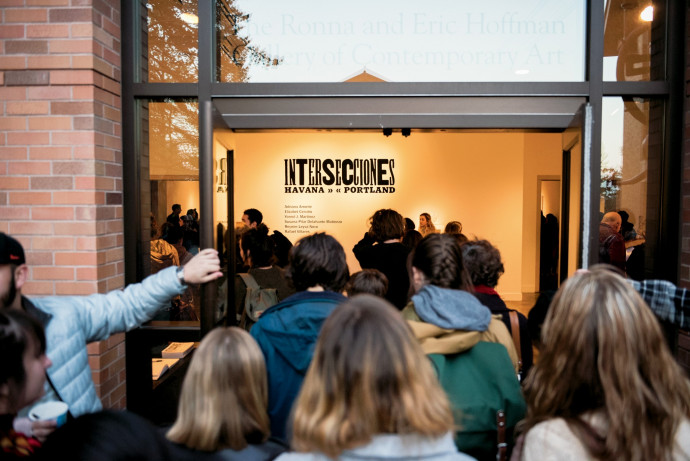
On Exhibit: Collaboration
Next came the hard part: getting the Cubans to Portland. On top of communication barriers—Internet access in Cuba is far from universal—there were diplomatic difficulties: the visa application for one of the artists, Susana Delahante, was initially denied. There is no official appeals process for such decisions, but Young reached out to Oregon Senator Ron Wyden, who agreed to write a letter on the artist’s behalf; Lewis & Clark President Barry Glassner also penned a letter of support. Delahante reapplied, and this time her visa was approved.
In the end, five of the six artists were able to come to Portland, where they created work that somehow linked Havana and Portland. One of Reynier Leyva Novo’s pieces, Manifest Destiny | The Weight of the Land, referenced both Oregon and Cuban history with its treatment of American expansionism. Rafael Villares’ ECO #10 used a tree stump and root system from Lewis & Clark’s campus. Arronte, a glass artist, crafted work for the exhibition in a residency at Tacoma’s Museum of Glass, which Tesner arranged.
“Adriana was the poster child of what a relationship [with an artist] could do,” Tesner says. “By her coming to Portland, and to Tacoma, we could impart an experience that pushed her in her career and was more valuable than just being in a group show.”
Lewis & Clark students also benefited from the exchange: recruits from the studio art department helped produce the show, from affixing about 1,000 Plexiglas bugs to the gallery walls for an installation piece by Arronte to hollowing out Villares’ tree stump. “As an art major, you’re exposed to artist lectures and events, but it’s uncommon to get to work in a professional art environment,” says Camilla Radoyce BA ’16, who helped mount Arronte’s piece. “This was a great way to get real-world experience.”
After a week and a half of somewhat frenzied art making, the exhibition opened to a well-attended student preview, followed by a packed public opening. “I don’t think I’ve ever seen that many people in the gallery,” Young says. “There’s a lot of interest in Cuba among students, and in the United States in general, and I think the show struck a chord.”
For Tesner, the success of Intersecciones is measured not only in attendance, but in how effectively the exhibition connected the Hoffman Gallery with other academic departments beyond art. “I think there really were reasons for students of other disciplines to come in and take a look at the work,” she says.
Young, too, touts the way in which the show united different parts of the institution. “One of the main successes for me was the way in which it involved students, the curriculum, alumni, faculty, and our overseas study program,” he says. “It brought everything together.” In its exploration of unexpected similarities between Havana and Portland, this global-minded exhibition ended up uncovering some local intersecciones: those within the Lewis & Clark community.
Funding for Intersecciones was provided by Lewis & Clark College, Reed College, the Regional Arts & Culture Council, and the National Endowment for the Humanities.
Jonathan Frochtzwajg BA ’09 is an independent journalist—and former Pioneer Log editor—whose work has been published in the Oregonian, Portland Monthly, and the Portland Business Journal, among others.
More L&C Magazine Stories
Lewis & Clark Magazine is located in McAfee on the Undergraduate Campus.
MSC: 19
email magazine@lclark.edu
voice 503-768-7970
fax 503-768-7969
The L&C Magazine staff welcomes letters and emails from readers about topics covered in the magazine. Correspondence must include your name and location and may be edited.
Lewis & Clark Magazine
Lewis & Clark
615 S. Palatine Hill Road MSC 19
Portland OR 97219
